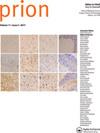水通道蛋白-1、-4和-9在多种朊病毒疾病大脑中的表达显著增强
IF 1.9
3区 生物学
Q4 BIOCHEMISTRY & MOLECULAR BIOLOGY
引用次数: 7
摘要
水通道蛋白(Aquaporins, AQPs)广泛表达于各类组织中,其中AQP1、AQP4和AQP9以表达为主,在脑各区域具有相对特殊的分布特征。AQP1和AQP4在阿尔茨海默病(AD)大脑中出现异常变化。为了评估朊病毒疾病中脑AQPs的潜在改变,本研究对139A、ME7和S15感染小鼠的痒病菌株进行了检测。Western blot结果显示,所有被检测的瘙痒病晚期小鼠脑组织AQP1、AQP4和AQP9水平均显著升高。对139A和me7感染小鼠在孵育期间不同时间点脑组织AQPs水平的分析显示,AQPs水平呈时间依赖性升高,尤其是在中晚期。在散发性克雅氏病(CJD)、致死性家族性失眠症(FFI)和G114V遗传性CJD (gCJD)患者等人类朊病毒疾病的皮质区,AQP1水平也有所升高。免疫组化(IHC)检测证实aqps阳性细胞形态呈星形细胞样;同时,在瘙痒病小鼠脑切片中也观察到大量不同大小的aqps阳性颗粒和点。免疫荧光分析(IFAs)表明AQPs的信号与GFAP阳性的增殖性星形胶质细胞的信号共定位,更有趣的是,在瘙痒病感染小鼠的大脑中,AQPs的信号似乎也与PrP的信号重叠。此外,用商业双染色系统进行的免疫组化检测显示,在痒病小鼠模型脑组织中,AQPs的分布区域不仅与活化的大星形胶质细胞重叠,而且与大量沉积的PrPSc重叠。我们的数据提供了有力的证据,证明脑AQP1、AQP4和AQP9的表达在各种小鼠瘙痒病感染模型中都异常增强。脑组织中积累的aqp与沉积的PrPSc之间的密切解剖学关联表明,异常增加的水通道蛋白参与了朊病毒疾病的发病机制。本文章由计算机程序翻译,如有差异,请以英文原文为准。
Significant enhanced expressions of aquaporin-1, -4 and -9 in the brains of various prion diseases
ABSTRACT Aquaporins (AQPs) are widely expressed in various types of tissues, among them AQP1, AQP4 and AQP9 are expressed predominately with relatively special distributing features in various brain regions. The aberrant changes of AQP1 and AQP4 have been observed in the brains of Alzheimer disease (AD). To evaluate the underlying alteration of brain AQPs in prion diseases, scrapie strains of 139A, ME7 and S15 infected mice were tested in this study. Western blots revealed markedly increased levels of AQP1, AQP4 and AQP9 in the brain tissues of all tested scrapie-infected mice collected at terminal stage. Analyses of the AQPs levels in the brain tissues collected at different time-points during incubation period showed time-dependent increased in 139A and ME7-infected mice, especially at the middle-late stage. The AQP1 levels also increased in the cortex regions of some human prion diseases, including the patients with sporadic Creutzfeldt-Jakob disease (CJD), fatal familial insomnia (FFI) and G114V genetic CJD (gCJD). Immunohistochemistry (IHC) assays verified that the AQPs-positive cells were astrocyte-like morphologically; meanwhile, numerous various sizes of AQPs-positive particles and dots were also observable in the brain sections of scrapie-infected mice. Immunofluorescent assays (IFAs) illustrated that the signals of AQPs colocalized with those of the GFAP positive proliferative astrocytes, and more interestingly, appeared to overlap also with the signals of PrP in the brains of scrapie-infected mice. Moreover, IHC assays with a commercial doublestain system revealed that distributing areas of AQPs overlapped not only with that of the activated large astrocytes, but also with that of abundantly deposited PrPSc in the brain tissues of scrapie murine models. Our data here propose the solid evidences that the expressions of brain AQP1, AQP4 and AQP9 are all aberrantly enhanced in various murine models of scrapie infection. The closely anatomical association between the accumulated AQPs and deposited PrPSc in the brain tissues indicates that the abnormally increased water channel proteins participate in the pathogenesis of prion diseases.
求助全文
通过发布文献求助,成功后即可免费获取论文全文。
去求助
来源期刊

Prion
生物-生化与分子生物学
CiteScore
5.20
自引率
4.30%
发文量
13
审稿时长
6-12 weeks
期刊介绍:
Prion is the first international peer-reviewed open access journal to focus exclusively on protein folding and misfolding, protein assembly disorders, protein-based and structural inheritance. The goal is to foster communication and rapid exchange of information through timely publication of important results using traditional as well as electronic formats. The overriding criteria for publication in Prion are originality, scientific merit and general interest.
 求助内容:
求助内容: 应助结果提醒方式:
应助结果提醒方式:


